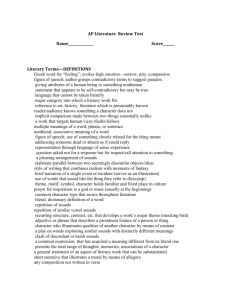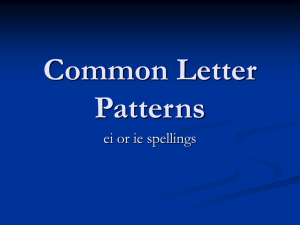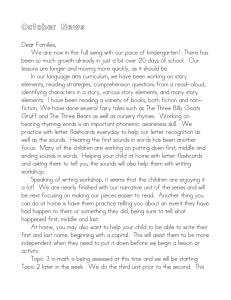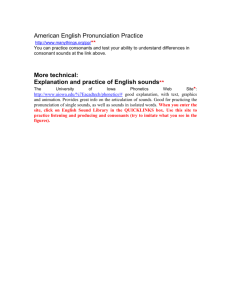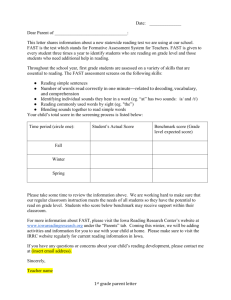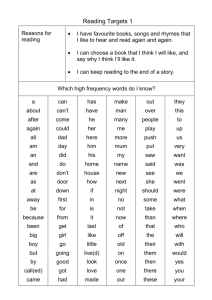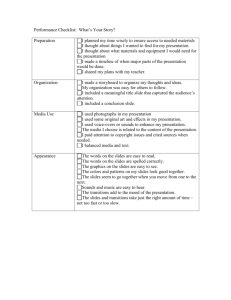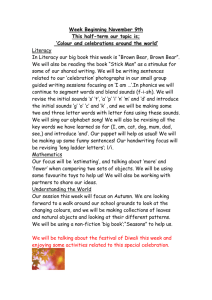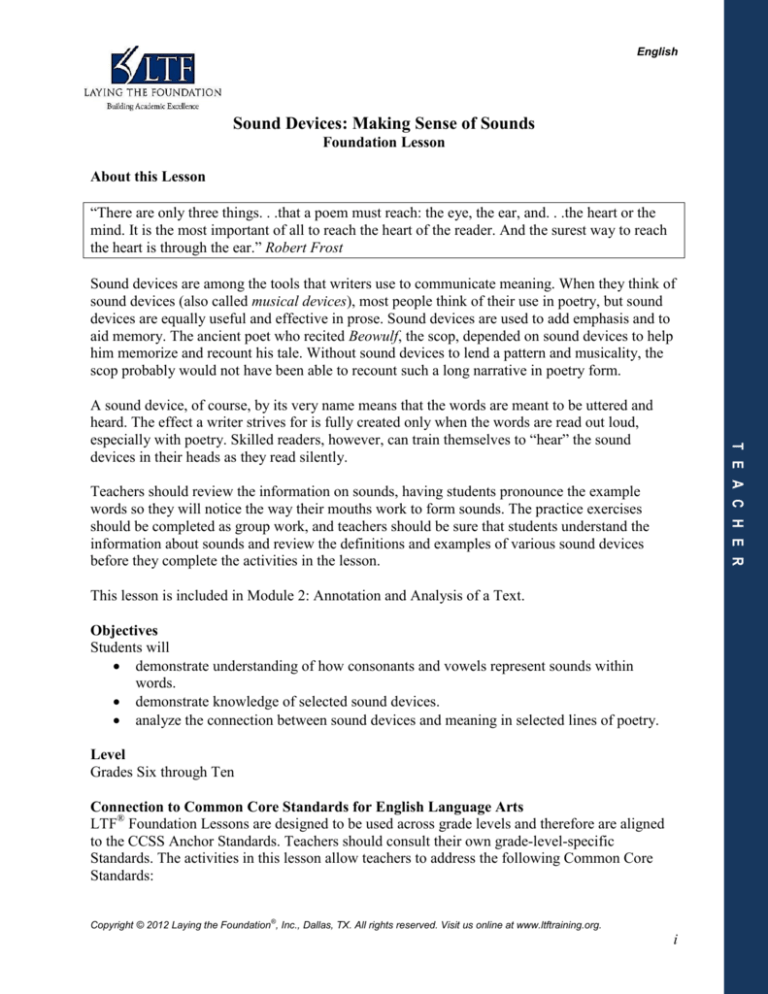
English
Sound Devices: Making Sense of Sounds
Foundation Lesson
About this Lesson
“There are only three things. . .that a poem must reach: the eye, the ear, and. . .the heart or the
mind. It is the most important of all to reach the heart of the reader. And the surest way to reach
the heart is through the ear.” Robert Frost
Sound devices are among the tools that writers use to communicate meaning. When they think of
sound devices (also called musical devices), most people think of their use in poetry, but sound
devices are equally useful and effective in prose. Sound devices are used to add emphasis and to
aid memory. The ancient poet who recited Beowulf, the scop, depended on sound devices to help
him memorize and recount his tale. Without sound devices to lend a pattern and musicality, the
scop probably would not have been able to recount such a long narrative in poetry form.
T E A C H E R
A sound device, of course, by its very name means that the words are meant to be uttered and
heard. The effect a writer strives for is fully created only when the words are read out loud,
especially with poetry. Skilled readers, however, can train themselves to “hear” the sound
devices in their heads as they read silently.
Teachers should review the information on sounds, having students pronounce the example
words so they will notice the way their mouths work to form sounds. The practice exercises
should be completed as group work, and teachers should be sure that students understand the
information about sounds and review the definitions and examples of various sound devices
before they complete the activities in the lesson.
This lesson is included in Module 2: Annotation and Analysis of a Text.
Objectives
Students will
demonstrate understanding of how consonants and vowels represent sounds within
words.
demonstrate knowledge of selected sound devices.
analyze the connection between sound devices and meaning in selected lines of poetry.
Level
Grades Six through Ten
Connection to Common Core Standards for English Language Arts
LTF® Foundation Lessons are designed to be used across grade levels and therefore are aligned
to the CCSS Anchor Standards. Teachers should consult their own grade-level-specific
Standards. The activities in this lesson allow teachers to address the following Common Core
Standards:
Copyright © 2012 Laying the Foundation®, Inc., Dallas, TX. All rights reserved. Visit us online at www.ltftraining.org.
i
Teacher Overview—Sound Devices
Explicitly addressed in this lesson
Code
Standard
R.1
R.4
R.5
R.10
W.2
SL.2
Implicitly addressed in this lesson
Code
Standard
L.1
L.2
L.3
W.4
Demonstrate command of the conventions of
standard English grammar and usage when writing
or speaking.
Demonstrate command of the conventions of
standard English capitalization, punctuation, and
spelling when writing.
Apply knowledge of language to understand how
language functions in different contexts, to make
effective choices for meaning or style, and to
comprehend more fully when reading or listening.
Produce clear and coherent writing in which the
development, organization, and style are appropriate
to task, purpose, and audience.
Depth of
Knowledge
III
Analyze
III
Analyze
III
Understand
II
Create
III
Apply
III
Evaluate
III
Level of
Thinking
Understand
Depth of
Knowledge
I
Understand
I
Understand
II
Create
III
T E A C H E R
W.10
Read closely to determine what the text says
explicitly and to make logical inferences from it.
Cite specific textual evidence when writing or
speaking to support conclusions drawn from the
text.
Interpret words and phrases as they are used in a
text, including determining technical, connotative,
and figurative meanings, and analyze how specific
word choices shape meaning or tone.
Analyze the structure of texts, including how
specific sentences, paragraphs, and larger portions
of the text (e.g., a section, chapter, scene or stanza)
relate to each other and the whole.
Read and comprehend complex literary and
informational texts independently and proficiently.
Write informative/explanatory texts to examine and
convey complex ideas and information clearly and
accurately through the effective selection,
organization, and analysis of content.
Write routinely over extended time frames (time for
research, reflection, and revision) and shorter time
frames (a single sitting or a day or two) for a range
of tasks, purposes, and audiences.
Integrate and evaluate information presented in
diverse media and formats, including visually,
quantitatively, and orally.
Level of
Thinking
Understand
Copyright © 2012 Laying the Foundation®, Inc., Dallas, TX. All rights reserved. Visit us online at www.ltftraining.org.
ii
Teacher Overview—Sound Devices
W.9
SL.6
Draw evidence from literary or informational texts
to support analysis, reflection, and research.
Adapt speech to a variety of contexts and
communicative tasks, demonstrating command of
formal English when indicated or appropriate.
Analyze
III
Understand
II
LTF Skill Focus
The foundation for LTF English lessons is the Skill Progression Chart that identifies key skills
for each domain, beginning with grade 6 and adding more complex skills at each subsequent
grade level while reinforcing skills introduced at previous grade levels. The Skill Focus for each
individual lesson identifies the skills actually addressed in that lesson.
Levels of Thinking
Remember
Understand
Apply
Analyze
Close Reading
Grammar
written, spoken, and visual texts
purposeful use of language for effect
Create
Composition
written, spoken, and visual products
Types (modes)
Expository
analytical
The Process of Composition
Prewriting
generation of ideas
selection of topic
Structural Elements
Body
topic sentence
use of commentary
use of evidence
Connections to AP*
Analysis of a writer’s use of sound devices and their effect on meaning and tone is a task that is
required of students in both the free response and multiple choice sections of the AP English
Literature Exam.
*Advanced Placement and AP are registered trademarks of the College Entrance Examination Board. The College
Board was not involved in the production of this material.
Materials and Resources
copies of Student Activity
Assessments
The following kinds of formative assessments are embedded in this lesson:
guided questions
brief writing assignments
Copyright © 2012 Laying the Foundation®, Inc., Dallas, TX. All rights reserved. Visit us online at www.ltftraining.org.
iii
T E A C H E R
Reading Strategies
Annotation
Literary Elements
Mood
Tone
Sound Devices
Alliteration
Assonance (7)
Consonance (7)
Meter (8)
Onomatopoeia
Rhyme
Rhythm
Evaluate
Teacher Overview—Sound Devices
Teaching Suggestions
Because this lesson emphasizes the connection between sound and meaning, it is important that
students complete this lesson in class with guidance from their teacher. Teachers should be very
familiar with the sound devices covered in this lesson and should work through the entire lesson
themselves before presenting it to their students.
Activity One includes lines from poems that are easily accessible by middle grades students.
Activities Two and Three become increasingly more challenging, but, with guidance, upper
middle grades students should be able to complete Activity Two. Teachers of middle grades
students may elect not to complete Activity Three with their students as it requires analysis of a
more complex text. Teachers of high school students, however, should complete the entire lesson
with their students.
Answers
Practice 1:
light, nice
rose, phone
Practice 2:
H
dark
H
canoe
S
hardly
S
S
H
speed, clean
mother
thin
zebra
S
S
H
water
late
there
Activity One:
1. The elephant complains that his trunk is so powerful that his sneezes crack and shatter
windows.
This scene is comic. The premise itself—that an elephant is trying to fit into human society—
is humorous. The visual image of windows cracking and shattering every time the elephant
sneezes adds to the humor.
2. Words that sound alike: sneeze, breeze; crack, impact
3. rhyme
4. Words that imitate the sounds they describe: sneeze, crack, shatter
5. onomatopoeia
6. meter
7.
/
/
/
My trunk is far too powerful,
/
/
/
no sooner do I sneeze
Copyright © 2012 Laying the Foundation®, Inc., Dallas, TX. All rights reserved. Visit us online at www.ltftraining.org.
iv
T E A C H E R
Practice 3:
Answers will vary. To obtain the maximum benefit for this exercise, ask students to go beyond
the expected responses.
Teacher Overview—Sound Devices
/
/
/
than windows crack and shatter
/
/
/
from the impact of the breeze
8. These lines are generally written in iambic meter (an unstressed syllable followed by a
stressed syllable). Middle grades teachers might refer to this as regular meter (created by
unstressed – stressed pattern) instead of as iambic meter.
9. The general meter, which creates a bouncy rhythm and a sing-song effect, contributes to the
light-hearted tone of the poem. The rhyme and onomatopoeia of the poem both suggest a
somewhat childlike innocence—like the naiveté of the elephant who wants to fit in with
human society.
Activity Two:
10. The gates of Erebus (or Hell) are swinging open suddenly with a loud and terrifying noise, a
noise so loud that it shakes the bottom of Erebus.
It is an unpleasant scene. The location—Erebus—is terrifying in itself; the fact that the gates
fly open suddenly and make such a horrible noise is equally terrifying. Words like harsh and
jarring emphasize the horrible noise made by the sudden opening of the gate.
12. Words with r sounds: recoil, jarring, infernal, doors, their, grate, Harsh, thunder, Erebus
These words are generally cacophonous.
13. The repetition of the r sound, a hard, “growling” sound, produces a harsh effect that suits the
subject of Milton’s lines. Some of the words themselves (jarring, grate, harsh, thunder)
connote harsh sounds like the spirits of the dead crying out for release.
14. Starlight (or light from the town) is reflected from the rocks as the day comes to an end. The
moon climbs in the night sky, and moaning noises are heard from the sea.
15. rhythm
16. One-syllable words: The, lights, to, from, the, rocks, The, long, day, wanes, the, slow, moon,
climbs, the, deep, Moans, round, with
17. assonance
18. Long o sound: slow, Moans
These words are euphonious.
19. The scene Tennyson describes has a soothing, quiet, reflective tone, emphasized by the
assonance in these words. The spondaic feet (repeated one-syllable words) similarly reflect
Copyright © 2012 Laying the Foundation®, Inc., Dallas, TX. All rights reserved. Visit us online at www.ltftraining.org.
v
T E A C H E R
11. consonance
Teacher Overview—Sound Devices
the winding down of the day, the slow climb of the moon, the general slowing of the pace of
life.
Activity Three:
20. Lines 1-3: The speaker likes to go out on a fall morning and find juicy blackberries to eat for
breakfast.
Lines 4-6: The blackberry stalks have thorns as if they are being punished for knowing how
to make such juicy berries.
Lines 6-9: When the speaker stands among the blackberries, it seems as if the ripest berries
fall into his mouth without any action from him, just as certain words sometimes seem to pop
into his mind.
Lines 9-11: These are words that have many letters but have only one syllable, so they seem
like lumps—words like strengths or squinched.
Lines 12-14: The speaker examines and “savors” these words, finding joy in them just as he
does in the blackberries. He extracts all the meaning from these words just as he extracts all
the flavor from the blackberries.
21. eating blackberries fresh off the vines on a fall morning
23. Answers will vary but might include the following:
Alliteration—love, late; black, blackberries, blackberries, black, blackberry; stand, stalks;
squeeze, squinch; silent, September; black, blackberry
Consonance—out, late, September, fat; black, blackberries, blackberries; breakfast, stalks;
making, lifting; stalks, ripest, almost; as, words, sometimes, words, strengths; silent, startled
24. Your mouth has to change positions and work really hard to pronounce the consonants in
these words, many of which are one-syllable words.
25. This action is similar to the act of eating a handful of juicy blackberries. The repeated b
sounds force the reader to purse his/her lips together, much the same way he/she would say,
“Mmmmmm. Good.”
26. One-syllable words: I, love, to, go, out, in, late, fat, black, to, eat, for, the, stalks, a, they,
earn, for, the, black, art, of, and, as, I, stand, them, the, stalks, to, my, mouth, the, fall, to, my,
as, words, do, words, like, strengths, or, squinched, lumps, which, I, squeeze, squinch, and,
splurge, well, in, the, black, of, in, late
27. The speaker eats the blackberries slowly, savoring each one.
28. peculiar words like “strengths” or “squinched”
29. one-syllable words that are made up of many letters
Copyright © 2012 Laying the Foundation®, Inc., Dallas, TX. All rights reserved. Visit us online at www.ltftraining.org.
vi
T E A C H E R
22. This experience is pleasant. The speaker says explicitly, “I love to go out. . .to eat
blackberries for breakfast.” The imagery and language he uses clearly show that he enjoys
this experience.
Teacher Overview—Sound Devices
30. Each blackberry is made up of many little segments, though it is still one blackberry, but it
takes all those little segments together to create the flavor and goodness of the blackberry.
31. Answers for this question are subjective and will vary. To obtain the maximum benefit of the
lesson, ask students to go beyond the expected responses.
T E A C H E R
Copyright © 2012 Laying the Foundation®, Inc., Dallas, TX. All rights reserved. Visit us online at www.ltftraining.org.
vii
English
Sound Devices: Making Sense of Sounds
Foundation Lesson
Finding Patterns and Contrasts in Sounds
One way students can learn to address a text is to find its patterns and contrasts. While we often
look for patterns and contrasts in the connotative words, images, symbols, and sentence patterns
writers use, we sometimes overlook similar patterns in the sounds of words, especially the words
of a poem. The letters that make up individual words are grouped into vowels and consonants.
Vowel Sounds
Each vowel (a, e, i, o, and u) represents a distinct sound, depending on where it occurs in a word.
For example, the letter a represents the same sound in each of these words: hat, bat, cat, sat.
But the letter a represents a different sound in each of these words: hate, late, mate, date. The
“silent e” at the ends of these words changes the sound of the letter a.
Practice 1: In each group of three words, circle the two words that contain the same vowel
sound:
sit
rose
speed
light
phone
pet
nice
cot
clean
Consonant Sounds
Consonants also represent distinct sounds, and these sounds are created by using various parts of
the mouth—the lips, the tongue, the teeth—and sometimes even part of the throat.
Say these words out loud, paying attention to the physical actions required to make the consonant
sounds:
purple, talent, simple, dungeon, murmur, river
Some of these consonant sounds are considered “soft” sounds, such as the m in “murmur” and
the s in “simple.” We generally refer to soft sounds as “euphonious1.”
Others are considered “hard” sounds, such as the r in “rough” and the d in “dungeon.” These
hard sounds are generally considered to be “cacophonous2.”
1
2
euphonious: pleasant in sound; agreeable to the ear
cacophonous: having a harsh or discordant sound
Copyright © 2012 Laying the Foundation®, Inc., Dallas, TX. All rights reserved. Visit us online at www.ltftraining.org.
1
Student Activity—Sound Devices
Some consonants may create either “hard” or “soft” sounds: The g in “garden” is a hard sound,
for example, but the g in “giant” is a soft sound.
Practice 2: Read the following words aloud, listening carefully to the first sound in each word.
Then label the word “H” if it begins with a hard consonant sound and “S” if it begins with a soft
consonant sound.
dark
mother
water
canoe
thin
late
hardly
zebra
there
Patterns of Sounds
Writers often use the sounds of words to reinforce their meanings. For example, in Heart of
Darkness, Marlow, the main character, describes the Congo River as a snake that hypnotizes him
and lures him toward danger. As he is traveling up the river, he offers this description:
“On silvery sand-banks, hippos and alligators sunned themselves side by side.”
Notice the repetition of the sss sound in these words, a sound we often associate with snakes.
This repetition reminds the reader of Marlow’s earlier description of the Congo:
“one river especially, a mighty big river, that you could see on the map, resembling an
immense snake uncoiled, with its head in the sea, its body at rest curving afar over a vast
country, and its tail lost in the depths of the land”
When we read, we should be conscious of the sounds of the words the writer chooses as well as
the emotional associations we have with those words and the images the words create for us. In
particular, we should watch for patterns and contrasts of sounds, just as we watch for patterns
and contrasts in connotations, images, symbols, and syntax.
Copyright © 2012 Laying the Foundation®, Inc., Dallas, TX. All rights reserved. Visit us online at www.ltftraining.org.
2
Student Activity—Sound Devices
Practice 3: Pretend you are writing a story or a poem, and you want to create a calm, quiet
mood. Thinking only about the sounds of the words, not their meanings, circle the four words
you would be most likely to choose:
lake
rain
spring
pond
mist
pool
downpour
creek
torrent
puddle
river
storm
waterfall
drizzle
brook
Now choose two of the words you have circled and write two sentences that explain why the
sounds of those words would help to create a calm, quiet mood.
Copyright © 2012 Laying the Foundation®, Inc., Dallas, TX. All rights reserved. Visit us online at www.ltftraining.org.
3
Student Activity—Sound Devices
Review of Sound Devices
Alliteration is the practice of beginning several consecutive or neighboring words with the same
consonant sound.
For example, in A Wrinkle in Time: “Over a Bunsen burner bubbled a big earthenware
dish of stew” (39). The repetition of the “b” sound reproduces the motion of the stew
simmering in its pot. It is a humorous moment, too, because Mrs. Murry cooks in the lab
where she does her scientific experiments, worrying her children that a chemical might
get mixed up with the food.
Assonance is the repetition of vowel sounds in a series of words. The words “cry” and “side”
have the same vowel sound and create assonance.
For example, Jane Eyre returns to Thornfield after her encounter with the stranger
(Rochester) whose horse slipped on ice and who needed her to help him. At this point
Thornfield is cozy but dull for her: “The hall was not dark, nor yet was it lit, only by the
high-hung bronze lamp: a warm glow suffused both it and the lower steps of the oak
staircase” (102). The repeated “o” gives the scene a mellowness, but all that will change
when she finds that the stranger she helped is Rochester who has arrived home.
Consonance is the repetition of a consonant sound within a series of words to produce a
harmonious effect.
In A Wrinkle in Time, the author describes the storm: “Behind the trees clouds scudded
frantically across the sky” (3). The repeated hard “c” sound recreates the chaotic harsh
movement in the stormy sky.
Onomatopoeia is the use of words that mimic the sounds they describe, for example, “hiss,”
“buzz,” “bang.”
Rhyme is the repetition of sounds in two or more words or phrases that appear close to each
other in a poem. End rhyme occurs at the end of lines; internal rhyme, within a line. A rhyme
scheme is the pattern of end rhymes.
In A Wrinkle in Time, Charles Wallace recites nursery rhymes, trying to save himself
from mind control:
Mary had a little lamb.
Its fleece was white as snow.
And everywhere that Mary went
The lamb was sure to go.
The second and fourth lines rhyme and help to connect the lines of the poem. The rhyme
scheme is abcb, showing the rhyme pattern.
Copyright © 2012 Laying the Foundation®, Inc., Dallas, TX. All rights reserved. Visit us online at www.ltftraining.org.
4
Student Activity—Sound Devices
Rhythm is the varying speed, intensity, elevation, pitch, loudness, and expressiveness of speech,
especially poetry.
The rhythm of this stanza from a song Rochester sings for Jane is iambic rhythm with the
first syllable unstressed and the second syllable stressed throughout:
Her coming was my hope each day,
(iambic tetrameter)
Her parting was my pain;
(iambic trimeter)
The chance that did her steps delay
(iambic tetrameter)
Was ice in every vein (239).
(iambic trimeter)
Meter is the measured, patterned arrangement of syllables according to stress and length in a
poem.
In the lines from the song Rochester sings to Jane, the meter alternates from tetrameter
(four stressed syllables per line) to trimeter (three stressed syllables per line). Authors
provide variations in rhythm and meter to keep poems from becoming repetitious or too
predictable.
Copyright © 2012 Laying the Foundation®, Inc., Dallas, TX. All rights reserved. Visit us online at www.ltftraining.org.
5
Student Activity—Sound Devices
Sound Devices in Poetry
When you analyze poetry, it is not enough merely to identify the sound devices.
You must also know and be able to explain the effect of the sound device in the passage.
Before completing Activity One, review the meanings of these poetic devices:
rhyme
meter
onomatopoeia
Activity One:
Read the following lines of poetry.
I shoot the Hippopotamus
with bullets made of platinum,
Because if I use leaden ones
his hide is sure to flatten ’em.
Hilaire Belloc, from “The Hippopotamus”
The sound devices in these lines create humor.
The rhyme is surprising and witty because of the unusual pairing of a multi-syllabic
word (“platinum”) with a colloquialism (“flatten ’em”).
The perfectly regular meter in these lines (with alternating stressed syllables) adds to the
humor by creating a sing-song effect: Read the lines out loud, emphasizing the syllables
that are in boldface:
I shoot the Hippopotamus
with bullets made of platinum,
Because if I use leaden ones
his hide is sure to flatten ’em.
Now read the following lines of poetry that describe the plight of an elephant trying to fit
into human society:
My trunk is far too powerful,
no sooner do I sneeze
than windows crack and shatter
from the impact of the breeze.
Jack Prelutsky, “It’s Hard to Be an Elephant”
1. Paraphrase Prelutsky’s description of this scene.
Copyright © 2012 Laying the Foundation®, Inc., Dallas, TX. All rights reserved. Visit us online at www.ltftraining.org.
6
Student Activity—Sound Devices
Is this a serious or a comic scene?
How do you know?
2. Underline the words in this passage that sound alike.
3. What is the term for the repetition of sounds in two or more words?
4. Circle the words that imitate the sounds they describe.
5. What is the term for words that imitate the sounds they describe?
6. What is the term for the regular, patterned arrangement of syllables according to stress and
length in a poem?
7. Read the lines out loud and put a slash mark (/) over each syllable that is stressed or
emphasized:
My trunk is far too powerful,
no sooner do I sneeze
than windows crack and shatter
from the impact of the breeze.
8. What kind of pattern is created by the emphasized syllables?
9. To be effective, the sounds of Prelutsky’s words should reflect the scene he is describing. How
do the rhyme, onomatopoeia, and meter help to create humor in these lines?
Copyright © 2012 Laying the Foundation®, Inc., Dallas, TX. All rights reserved. Visit us online at www.ltftraining.org.
7
Student Activity—Sound Devices
Before completing Activity Two, review the meanings of these poetic devices:
consonance
rhythm
assonance
Activity Two
Read the following line of poetry:
“All day the out-cast crows croak hoarsely across the whiteness.”
Elizabeth Coatsworth
The sound devices in this line create a jarring cacophony of the raucous sounds the crows make.
The hard “k” sound occurs four times: “out-cast crows croak. . .across.”
Several syllables in a row are stressed, slowing down the pace and producing a rough
rhythm: “out-cast crows croak.”
The long “o” sound, a sound usually associated with mournfulness or solemnity, occurs
twice: “crows croak.”
Now read this passage, John Milton’s description of the opening of the gates of hell:
On a sudden open fly
With impetuous recoil and jarring sound
The infernal doors, and on their hinges grate
Harsh thunder, that the lowest bottom shook
Of Erebus3.
John Milton, from Paradise Lost
10. Paraphrase the scene Milton is describing.
Is it a pleasant or an unpleasant scene?
How do you know?
11. What is the term for the repetition of consonant sounds within or at the ends of a series of
words?
12. Underline the words that include the r sound. Are these words euphonious (pleasant) or
cacophonous (harsh)?
3
Erebus: in classical mythology, the darkness below the earth, thought to be the abode of the dead
Copyright © 2012 Laying the Foundation®, Inc., Dallas, TX. All rights reserved. Visit us online at www.ltftraining.org.
8
Student Activity—Sound Devices
13. To be effective, the sounds of Milton’s words should reflect the scene he is describing. How
do the hard “r” sounds help to reflect the scene he is describing in these lines?
Read this passage, describing the end of the day, the coming of nighttime:
The lights begin to twinkle from the rocks;
The long day wanes; the slow moon climbs, the deep
Moans round with many voices. . .
Alfred, Lord Tennyson, from “Ulysses”
14. Paraphrase Tennyson’s description of this scene.
15. What is the term that describes the varying speed, intensity, elevation, or pitch in speech?
16. Circle the one-syllable words in this passage. How do these words slow the pace of the lines?
17. What is the term for the repetition of vowel sounds in a series of words?
18. Underline the words that include a long o sound (as in “bone”). Are these words euphonious
or cacophonous?
19. How do the long o sounds and the slow pace reflect the scene Tennyson is describing?
Copyright © 2012 Laying the Foundation®, Inc., Dallas, TX. All rights reserved. Visit us online at www.ltftraining.org.
9
Student Activity—Sound Devices
Activity Three: Carefully read the poem below; then answer the questions that follow it.
Blackberry Eating
I love to go out in late September
among fat, overripe, icy, black blackberries
to eat blackberries for breakfast,
the stalks very prickly, a penalty
they earn for knowing the black art
of blackberry-making; and as I stand among them
lifting the stalks to my mouth, the ripest berries
fall almost unbidden to my tongue,
as words sometimes do, certain peculiar words
like strengths or squinched,
many-lettered, one-syllabled lumps,
which I squeeze, squinch open, and splurge well
in the silent, startled, icy, black language
of blackberry-eating in late September.
5
10
—Galway Kinnell
20. Paraphrase the following lines:
lines 1-3:
lines 4-6 (to the semicolon):
lines 6 (after the semicolon)-9 (to the comma):
lines 9 (after the comma)-11:
lines 12-14:
21. What activity is the speaker describing in this poem?
22. To the speaker, is this scene pleasant or unpleasant?
Copyright © 2012 Laying the Foundation®, Inc., Dallas, TX. All rights reserved. Visit us online at www.ltftraining.org.
10
Student Activity—Sound Devices
How do you know?
23. Find and circle examples of alliteration and consonance in this poem.
24. Read aloud the words you have circled without reading the rest of the poem. What do you
notice about the way your mouth works to pronounce these words?
25. How is this action related to the subject of the poem?
26. Underline all of the one-syllable words in this poem. How do these one-syllable words affect
the speed with which you read this poem?
27. How does this speed (or lack of speed) relate to the action the speaker is describing and his
feelings about that action?
28. Now read again lines 6-9 (beginning with “and as I stand”). In these lines, what does the
speaker compare to the “berries [that] fall almost unbidden to [his] tongue”?
29. What are the “many-lettered, one-syllabled lumps” the speaker mentions in line 11?
30. How are the blackberries like these words?
Copyright © 2012 Laying the Foundation®, Inc., Dallas, TX. All rights reserved. Visit us online at www.ltftraining.org.
11
Student Activity—Sound Devices
31. In the space below, write a well-organized paragraph analyzing how the writer uses sound
devices to reflect his feelings about eating blackberries.
Copyright © 2012 Laying the Foundation®, Inc., Dallas, TX. All rights reserved. Visit us online at www.ltftraining.org.
12

